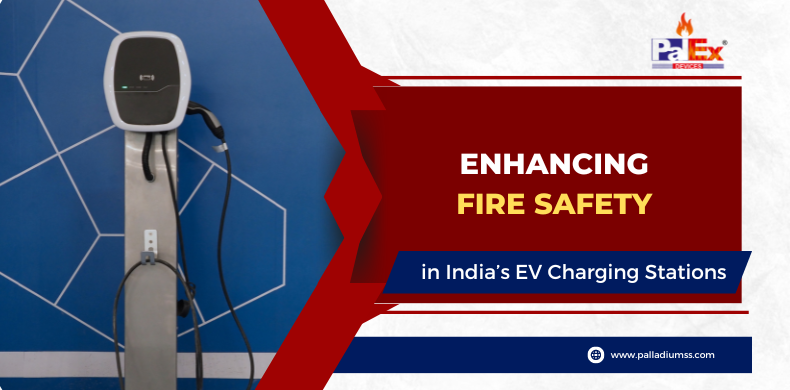Electric vehicles (EVs) are starting to charge up India’s transportation sector. As part of the country’s aim to reach net-zero carbon emissions by 2070, the government has set ambitious targets for EV adoption over the next decade. By 2030, it wants electric models to make up 30% of private cars, 70% of commercial vehicles, and 80% of two and three-wheelers sold.
To support this vision, India needs to build out a vast, convenient, and reliable charging infrastructure. The government plans to install EV chargers at most existing petrol pumps across the country. Parking spaces in apartment buildings, offices, malls, and other private establishments will also need charging facilities.
While this infrastructure rollout will allow easy EV charging access for owners, it also raises an urgent need to enhance fire safety. EV fires have made headlines globally, especially with electric two-wheelers. Experts have identified potential fire triggers during charging including battery defects, short circuits, overheating, voltage fluctuations, and even negligence. As India’s EV ecosystem expands exponentially, charging fires could become a worrying trend. We need protocols and solutions to prevent such incidents and protect people and property.
Understanding EV Fire Risks
Lithium-ion batteries power most modern EVs. Though safe when operating normally, these batteries contain inflammable electrolytes. Internal defects or external factors can trigger thermal runaways – uncontrolled overheating leading to fires.
Experts compare EV battery chemistry to that of a gas cylinder. Cylinder explosions from leaks or ruptures can level buildings. Similarly, burning battery cells can release enough heat to melt metal and be impossible to extinguish. Toxic smoke can also endanger human life.
In India, the surge in low-speed electric two-wheelers heightens fire risks. Affordable EV bikes feature low-quality cells bundled together to deliver range. Weak quality controls and cell damage from potholed roads increase instability. Meanwhile, homeowners plug vehicles inside living spaces, endangering families.
Global EV brands have endured battery fire incidents too. But their cases mostly emerge from violent collisions rupturing battery packs – not from charging. Stringent safety testing minimizes risks of internal defects. This showcases the need for manufacturing vigilance along with charging protocols tailored for India’s unique EV ecosystem.
Safety Starts with Standards
Robust standards can help safeguard India’s EV charging infrastructure. BIS, India’s standards institution, has developed guidelines around connector types, charger installation, swappable batteries, and safety requirements. Wide adoption by charger manufacturers can ensure basic precautions are built into hardware.
Meanwhile, the government has proposed making certification by ARAI, India’s leading automobile R&D body, mandatory for EV components. ARAI tests for water, dust, and temperature protection along with electrical and mechanical safety. Compulsory ARAI certification will help quality control for parts like batteries, battery management systems, and charging equipment.
Globally, TUV Rheinland, UL Solutions, and other third-party safety testers offer EV and charger certification too. As India’s EV industry matures, manufacturers can aim for testing benchmarks meeting global standards. Safety ratings like IP67 for water/dust resistance, IK08 for impact protection, or UL94 V-0 for flammability will verify parts are built to last in Indian conditions.
Protective Protocols
With quality parts in place, sound installation, and maintenance protocols can further cut risks. Strict guidelines cover residential and public charging infrastructure.
Homeowners should install personal EV chargers only after electrical inspections of wiring conditions. Dedicated circuits for EV charging equipment minimize the risks of short circuits or overloads.
Public charging parks need centralized monitoring systems. Hardware checks for voltage fluctuations, leakages, or overheating issues. The system can automatically re-route power or even cut it off to isolate risks. CCTV monitoring also allows human intervention in emergencies.
Robust maintenance regimes are critical too. Charging equipment exposed to weather or public handling wears out over time. Regular upkeep checks for loosened connectors, damaged plugs, or leaks – nipping potential trouble in the bud. Professional manned stations also oversee charging protocol compliance.
Also read : 10 Causes of House Fire
Fire Detection & Suppression Innovations
Alongside prevention mechanisms, India’s EV infrastructure should integrate advanced fire safety technologies too. AI-powered systems can spot fires before they spread and enable appropriate responses.
Heat and smoke detectors with IoT connectivity form the first line of alarm. On detecting anomalies, these triggers can shut off chargers remotely while alerting first responders instantly over cloud networks.
Another innovation relies on computer vision through cameras around charging stations. Video footage runs through machine learning algorithms to identify sparks, smoke, or odd thermal patterns accurately. Automated suppression systems engage when needed, preventing small sparks from turning into blazes.
Dousing EV battery fires requires special solutions too. Water dangerously reacts with lithium-ion cells. So dedicated EV fire trucks carry hundreds of kilos of fire retardant resin instead. The sticky substance coats cells to seal off oxygen that feeds fires. India must expand access to such elite firefighting gear across states to tackle large blazes.
Building a Safety-First Network
As India sets up lakhs of charging points in the coming years, integrating safety frameworks from the ground up is crucial. Standards, testing, and R&D around risk minimization for EVs tailored to Indian conditions deserve urgent focus. Investments into fire preparedness through training, equipment upgrades, and fail-safe technologies will prove invaluable too.
Most importantly, public awareness campaigns should promote safe charging etiquette across homes, workplaces, and commercial zones. As EV adoption gathers speed, building a shared culture of safety-first among manufacturers, government bodies, and customers can electrify India’s transportation without deadly pitfalls.
The future promises cleaner and greener commute options. But India cannot afford to take the power of EVs for granted. With prudent planning and sustained efforts, we can ensure charging networks energize sustainable mobility without putting lives and property in peril.



